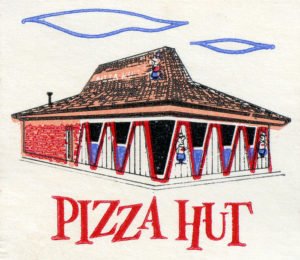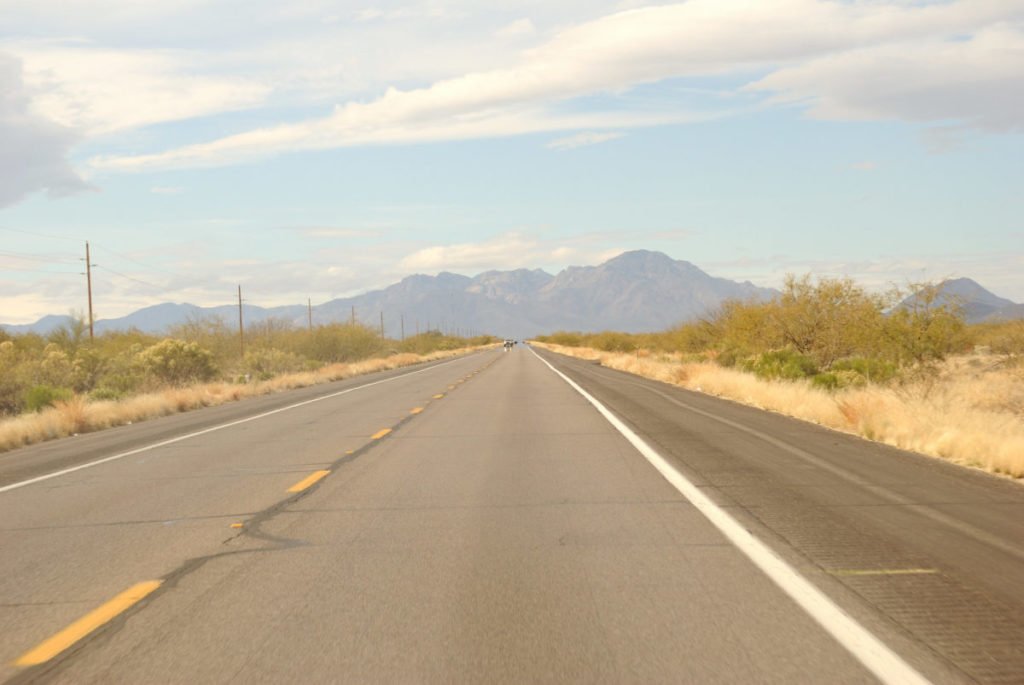There’s a scuba certification center in the middle of the desert, promising a deep heated pool. There’s a billboard with a picture of an elderly couple smiling for the camera, the woman wrapping her arms around the man’s shoulders from behind, with bold white text declaring, “E.D.? Keep the love going!” There’s a prison complex that’s all dirt and barbed wire, directly across from a shopping center advertising multiple designer brands and large stores with mission-style architecture. I stare from the window of a bus as they pass. I’ve driven this highway—which connects my college home and my real home—many times, but I’m usually too focused on navigating to really remark on all the different sights.

Every time I make the drive, though, I do take a second to marvel at certain darlings of mine as they pass. The favorite of all my favorites is what I call “the liminal Pizza Hut,” which stands alone on the side of the interstate, beckoning travelers with its towering signage. A small circle of asphalt around it turns without warning to sand and rocks, like a strange island in the desert expanse. Beyond an underpass, there is a storage facility for semi-trucks and a red motel, where I once watched in awe as a woman with messy hair and wrinkled clothes leaned over the balcony to take lazy drags of a cigarette. It’s not the sort of place tourists stay, because tourists don’t travel to the middle of the desert except to see the Grand Canyon or some other natural wonder. This stretch of highway is no wonder, boasting only of dull cacti and grayish brown sand, and is only beautiful if you find monotony beautiful. No, the motel is not an attraction.
Obviously, this Pizza Hut is not sustained only by business from motel-stayers and semi-truck drivers, yet it’s also clearly not the sort of store you’d call to order pizza for a birthday party. I’ve toyed with the idea of pulling over, waiting in the dining area, and asking everyone who enters where they’re from and where they’re going. I could lie and say it’s for a school project. (Lord knows those liberal university hippies will assign anything these days.) I don’t know if this would succeed in anchoring the place and its people to reality, because I’ve never found the time to actually stop.
Another of my favorites is what my dad and I lovingly nicknamed the trash triangle, an exit that houses a gimmicky old-western rest stop, a tiny sex shop alone atop a hill, and a roadside attraction where you can feed an ostrich or see a monster truck. The ostrich farm is one roadside attraction I’ve actually stopped to visit, figuring I had nothing to lose except for fifteen dollars and an hour of my time. The employees spoke with what I assume was a fake southern accent, since no one in Arizona actually talks like that. I sent little green pellets up to goats in their “Goat Penthouse,” a forklift suspended far above the roadside where three goats were trapped to wait for food delivery from benevolent travelers. At the station labeled, “Hole in the Wall Gang,” goats smacked their lips at me from, as the name might suggest, holes in the wall large enough to push their heads through. One managed to get a sore-covered leg out of the hole, which he waved at me until I walked away. A little girl, about five, talked to a friend of hers about how cute the sheep were and how it was a shame they had to slaughter them on her uncle’s farm. I just walked around with my usual indifference, observing like an ethnographer while families genuinely enjoyed themselves, absent-mindedly handing off pellets to a blind goat with an American flag tied around his neck.
But outside of these particularities, I have not fully been able to appreciate the highway, so this bus ride is a welcome opportunity to see more interstate oddities, especially with a dead phone and no desire to talk to any of the other passengers. Maybe I’m just disconnected enough to find irony in the fact that I care so much about what other humans build in a desert wasteland while refusing to actually connect to any other human being.
Much of the drive is desert, and I’ve never found cacti particularly beautiful. When you grow up in the West you see too many of them, and have too many memories of getting pricked. (Such as when I, about five, decided sitting down on a barrel cactus would be a great plan. I spent roughly an hour bathing in hot water while my poor parents had to tweeze each individual spike out of my ass.) Cacti are neither beautiful nor ugly to me; they just are. And yet there’s a majesty to turning a curve and watching a canyon appear before me, filled with cacti that climb up the plateaus, looking almost human, so many of them together that the sea of brownish-green almost—almost—feels like a forest, illuminated by the final glow of a fading sunset.
As the last few streaks of red fade and the sky shifts to a deep, dark blue, we enter civilization, heralded by three sex shops from the same chain appearing within ten minutes of the drive. I’m ashamed to admit I find more majesty in these than I do in the natural wonder of cacti, mostly because of the mystery. Cacti grow in the desert—that’s a given. But who are these people who see a store on the side of the highway, and decide that they really need to pick up a dildo or two? My dad says it’s for truckers to stop and buy DVDs, but that seems like a relic of a time when you couldn’t Google your porn, so I can’t imagine that drives the profits. The one time I stopped out of curiosity at the sex shop in my beloved trash triangle, a couple was amicably chatting with the woman at the counter. She knew them by name, and they were laughing together with such familiarity that implied that they were regulars. So, I suppose there are customers.
It can’t be more than a few more miles before we pass the first (not the only, but the first) megachurch. The building has multiple annexes and a parking lot that I doubt could be easily filled, so that I think it’s a mall the first time I see it. The inviting, pale blue of the buildings also is more typical of commercialism than of religion. Much like my liminal Pizza Hut or the copious isolated sex shops, I have to wonder who this middle-of-nowhere interstate church is meant for. Are there families that don their Sunday best every week to sit in these pews? Do the truckers stop by to repent after picking up their pornos? Another megachurch has billboards up and down the route, using text language (“r u bored?”) and various condescending slogans implying, perhaps correctly, that we highway riders would only be interested in a church that promised high-energy fun as well as salvation. So maybe the goal is for people like me, who mock the roadside while taking so much pleasure in the sights, to meander into the church in some ironic journey and stumble upon the glory of our Lord and Savior Jesus Christ.
Actually, it doesn’t even matter who comes to this church. Highways don’t seem to exist in the world of logic. Pizza Huts off the interstate don’t need business to thrive; they exist because they do, and that’s the end of it. And there are few things in life as honest as a sex shop or an interstate church. Vending sin or salvation, neither location apologizes for its presence. I don’t have much time to stare before we’re on our way again, but I notice a coffee shop attached to the main building. The name? “HeBrews.” If the church’s only goal is to get me to notice it, it’s succeeded.
I hear murmurs drifting throughout the bus, and suddenly see nothing but red brake lights stretching out so far ahead of us that I can’t see an end. A faint honking sounds from further ahead in the traffic. There’s always someone who thinks that if they honk at the traffic it’ll bend to their will and immediately disperse, because they’re in a hurry, goddamn it. A girl who’s already googling an explanation tells us there’s a twenty-four mile traffic jam. Beside us, a child in the backseat of an SUV has his face illuminated by a light blue glow of his parent’s iPhone. Or potentially his own iPhone; have I become old enough to find that cultural shift disturbing, as though time should be frozen to when children only had “Shrek phones” with little green antenna to call three pre-programmed numbers?
“It better be a big accident,” one passenger says, annoyed. Others make various stunned remarks and tell her she shouldn’t joke about something that. “I mean obviously I hope no one’s hurt,” she adds, “just that a semi, like, dumped a bunch of fruit on the road or something.”

Slight creep forward. There’s a truck beside us now, with a caged dog in the truck bed—a German Shepard, I think—moving its head back and forth to look at the chaos. The rest of the truck bed is piled high with boxes. A passenger, who looks like a teenage boy although I can’t be sure, is thrashing to the beat of unheard music, whipping his hair and pumping his fists while the driver watches him, amused. A man in the backseat of another car almost makes eye contact with me as I, my forehead pressed against the bus window, stare at him, his forehead pressed against his car window. I look away when he moves his eyes toward mine. I want to see and not be seen.
“I looked it up,” the girl with her phone shouts back to the rest of us. “There was an accident. Two semis. One guy died. Both ways are blocked until the police can clean up and investigate.” The bus groans, half in sympathy and half in frustration at the inconvenience. I am not sure which side I’m on. The hippie in me wants to feel some connectedness a stranger’s suffering, but the millennial in me is facing the prospect of more time away from my phone. I don’t have the energy for a moral crisis.
Next to us, I see a man rubbing his face in frustration over and over again. I think of the animatronics in Disneyland rides, and of how realistic they look with their shiny skin and fluid movements. But then the ride breaks and you watch them run through the same sequence in an endless cycle, and all that realism fades. You’re just watching a half-being condemned to repeat and repeat and repeat and repeat until the ride sputters to a start and you can forget them again. The man keeps rubbing his face. It’s all wrong, but I can’t look away. The bus won’t move forward. He won’t stop.
I close my eyes and clasp my hands. I want to pray, as I do so often when I don’t know what else I can do, although I’m a heretic with no practice at proper prayer. I want to tell God something profound, call him to action, say something that matters. I want to send some sympathy to this poor dead driver and his poor grieving family, who I don’t know and who I won’t likely think about once I’m home, alive.
Instead I murmur quietly enough so no one can hear me, “I’m sorry.”
I don’t know what I’m sorry for.
“I’m sorry,” I repeat, and then, like the man rubbing his face, I can’t stop. “I’m sorry I’m sorry I’m sorry I’m sorry.” I’m still quiet enough that no one can hear me over their chatter, speculating about the dead man.
If I’m being honest, maybe I do know what I’m sorry for.
“I’m sorry I’m sorry I’m sorry I’m sorry.” I’m stuck in a loop of ritual, and I know once I’ve started I can’t end it, or else it’ll just bubble back up to the surface, rot within me. It’ll haunt me for the rest of the night if let the sequence rest unfinished. I don’t know when I’ll finish. I have to finish.
The words of my apology blur into one another until they lose all meaning. I’m sorry for the fact that they never meant anything to begin with. Even my prayer, meant to be selfless, is about my own selfish guilt for being alive and ungrateful. That’s one fascinating tidbit about fielding suicidal ideation since preschool: every other death seems like an injustice, or a harbinger. The Secret in reverse, I have thought about death so much that I manifest it on unsuspecting victims. This poor truck driver would be alive if I were less depressed.
We can finally see where the string of brake lights ends, and as we drive by, the girl who hoped for an accident severe enough to warrant the inconvenience says, “Oh, it’s not even that bad.” Which is true, until we glance to the other side of the road, where a heap of wreckage is piled. Police lights light up the mangled truck with flashes of red, white, and blue.
“I’m sorry,” I say one more time in the now-silent bus. I realize that the compulsion has finally let me go; I can stop without feeling my lungs constrict. I unclasp my hands, and gaze out the bus window yet again as we race onward, past the wreckage, past the memory of a dead man.
There’s an empty stretch of highway for quite a while, which I watch intently although there’s nothing to see. There’s a sign telling me that “Christ is the answer” that I’ve seen before, but never at night—at night, there’s a glowing cross formed from Christmas lights that rests above the declaration. I doubt the premise of the statement, but even my cynicism can’t find fault with the sincerity. And Lord knows I could use some of that sincerity myself.
Mercifully, our exit appears, and I can finally close my eyes for the few minutes until I’m back in a permanent world.

Share this post with your friends.

